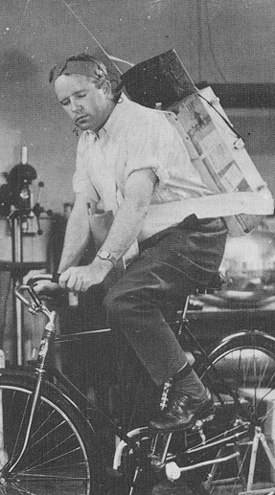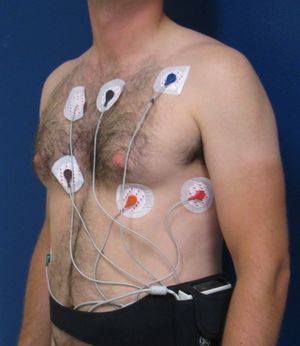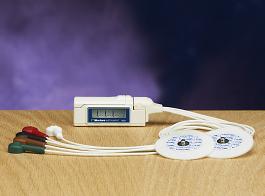Holter: Difference between revisions
Jump to navigation
Jump to search
mNo edit summary |
No edit summary |
||
| Line 3: | Line 3: | ||
[[Image:Holter.jpg|thumb| A mordern 3 channel Holter monitor the size of a small battery.]] | [[Image:Holter.jpg|thumb| A mordern 3 channel Holter monitor the size of a small battery.]] | ||
Holter monitoring has been named after it's discoverer | Holter monitoring has been named after it's discoverer, physicist [[w:Norman Holter|Norman J. Holter]] (and therefore it is written with a capital H). It is a portable ECG recorder (sometimes called a '''portable loop recorder''') which usually records every heart beat during 24 hours. | ||
Holter recordings are often used in patients with paroxysmal arrhythmias, in whom registration on a single ECG has not succeeded. A 24 hours registration shows the frequency and type of arrhythmias. The patient is asked to make notes in a diary if symptoms occur, so these can be matched with the recording. | Holter recordings are often used in patients with paroxysmal arrhythmias, in whom registration on a single ECG has not succeeded. A 24 hours registration shows the frequency and type of arrhythmias. The patient is asked to make notes in a diary if symptoms occur, so these can be matched with the recording. | ||
{{clr}} | {{clr}} | ||
Latest revision as of 07:00, 20 October 2010
Holter monitoring has been named after it's discoverer, physicist Norman J. Holter (and therefore it is written with a capital H). It is a portable ECG recorder (sometimes called a portable loop recorder) which usually records every heart beat during 24 hours. Holter recordings are often used in patients with paroxysmal arrhythmias, in whom registration on a single ECG has not succeeded. A 24 hours registration shows the frequency and type of arrhythmias. The patient is asked to make notes in a diary if symptoms occur, so these can be matched with the recording.


